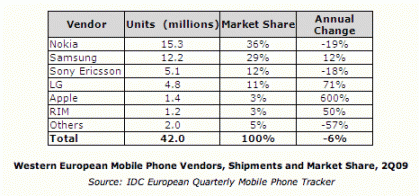Enough has been written about the success of the iPhone. It’s been truly a game changer. Some recent statistics will help us keep the success in perspective.
In the first weekend after launching the 3G iPhone Apple sold 1 million phones. Compare this when Apple sold 6.4 million units of its first generation phones in one full year after launch. Based on some preliminary analysis, the gross margins for the 3G phones are above 60%. Currently the iPhone 3GS (16GB) is priced at $199 and the 32GB model at $299. Well, one can expect some price discounting, but even then the margins are pretty healthy.
If the device has been a runaway success, the App Store with over 65,000 applications and about 1.5 billion downloads has been another game changer, much in the same way the ITunes store bolstered the sale of iPod devices.
Apple has only a 3% market share of the global cellphone sales, yet it actually actually accounts for 35% of the entire industry’s operating profits. A Deutsche Bank’s report actually states that before the end of the year Apple and RIM may have a combined market share of 5%, yet account for 65% of the industry’s profit.
In contrast, Nokia the market share leader has been struggling. In the most recent quarter it reported a 25% drop in sales and a 66% drop in earnings. The company has lost over half its value in the last 12 months. Clearly the company has failed to respond adequately to the threats of Apple, RIM and Google’s Android.
There’s nothing noteworthy about Sony-Ericsson, Samsung or LG. Motorola has clearly lost the game. HTC and Palm are new players in the game and their future will be determined in 2 years time.
What’s equally amazing to me is how numerous Japanese companies like NEC, Sharp, Panasonic who make excellent cellphones have largely confined themselves to Japan and never seized the opportunity to go global. An excellent analysis of this phenomenon is covered here. The analysis is interesting (recommended reading) and highlights the fact that as the underlying ground shifts from hardware to software, the Japanese companies may be found increasingly wanting compared to the iPhone and Android.
In hindsight, everyone knows that Apple created a game changer. But hindsight is 20/20. And everyone who’s studied Apple over the years would say that this was a replication of the iPod/iTunes phenomenon.
The key thing is not just a great technology wrapped in a cool design as most people believe it to be. I believe that they took a great technology and wrapped it in a great business model. It was truly a business model innovation redistributing the billions of dollars of value.
But here are some of the questions for which I am keen to hear views:
- Did Apple see the weaknesses of the incumbents and then develop the complete business model? Were they prescient about the future course of events?
- Were the incumbents (Nokia, Motorola, Samsung, Sony) too lazy or unimaginative with their competitive responses even when news got around that Apple could announce a iPhone?
- Did Apple’s innovation with the business model, technology, and its eventual success laid bare the inefficiencies of other players?
- Is a consolidation in the mobile phone industry imminent in the next couple of years? What are the likely scenarios?

